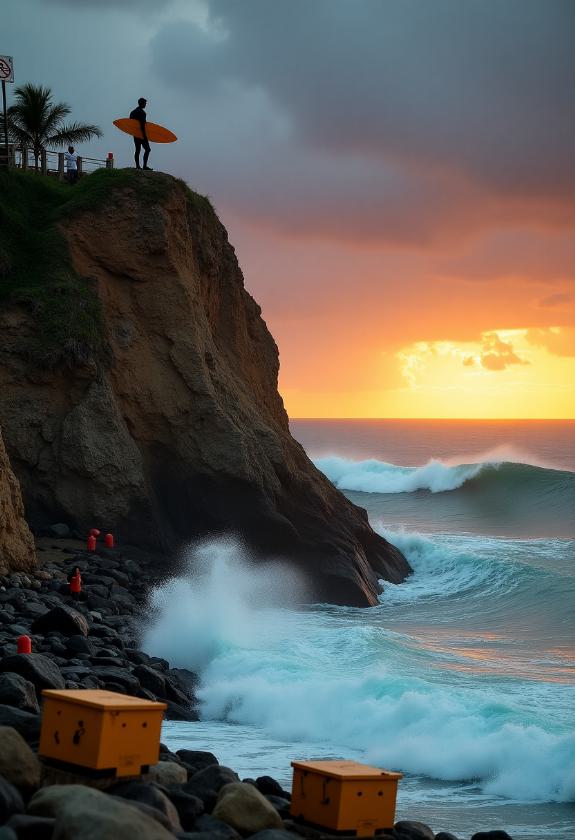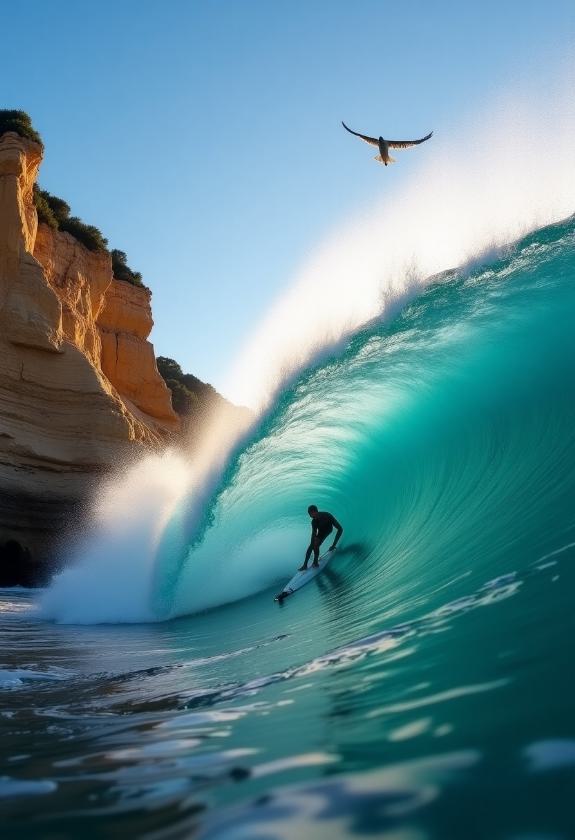
You’ll find pristine, uncrowded surf breaks along Yorke Peninsula’s rugged coastline.
Berry Bay offers clear waters and consistent waves for beginners, while Corny Point’s 2km stretch delivers manageable swells perfect for learning.
Advanced surfers can’t miss Chinamans with its powerful left-hand reef break or Trespassers’ monster right-hand waves reaching up to 3 meters.
Daly Head, Australia’s first National Surfing Reserve, showcases heavy waves up to 4 meters.
The best conditions occur during autumn and winter, with early mornings offering clean offshore winds.
Let’s explore which break matches your skill level and surfing style.
Why Surf Yorke Peninsula?

The Yorke Peninsula delivers everything an avid surfer could want if you’re searching for an exceptional surfing destination off the beaten path.
You’ll discover pristine, uncrowded breaks where you can catch waves without the typical hustle for a common position at more popular spots.
What makes this destination truly special is its diverse geography, offering both sheltered bays and exposed ocean beaches.
You’ll find yourself surfing year-round thanks to the Mediterranean climate, with spots like Chinaman’s and West Cape in Innes National Park providing world-class waves.
Whether you’re drawn to point breaks or beach breaks, there’s a perfect spot waiting for you. The Peninsula’s tight-knit surfing community welcomes visitors with open arms.
The stunning limestone cliffs and sandy beaches create a spectacular backdrop for your surfing adventure, and you might even spot some unique wildlife between sets.
When To Hit The Waves
Timing your surf session at Yorke Peninsula can make the difference between an average day and an epic one.
The best conditions are autumn and winter when the swells are more consistent and the winds are favourable.
I recommend hitting the waves early in the morning or late afternoon when offshore winds create clean conditions perfect for surfing.
You’ll want to check the tide and wind direction for specific breaks.
Daly Head, recognised in 2013 as the first National Surfing Reserve on Australia’s southern coastline, boasts world-class waves year-round.
Scattered across the Peninsula are popular breaks and hidden gems waiting to be discovered.
Chinaman’s comes alive during low to medium tide with north or north-westerly winds, while Trespassers works best with easterly winds.
If you’re heading to Ethel Wreck, time your visit during low to medium tide with east to northeast winds.
Remember to check the surf reports before you go—they’re essential for finding the perfect conditions at your chosen break.
Essential Safety Tips

Safety at Yorke Peninsula’s surf spots requires thorough preparation and local knowledge.
Before paddling out, you’ll want to check the day’s surf forecast and wind conditions. I’ve found local surf reports to be incredibly reliable.
Wear the right wetsuit for the water temperature, and always use a leg rope.
I recommend getting familiar with the specific break you’re surfing—know where the rocks are, understand how the tides affect wave conditions, and identify your exit points.
Located three hours from Adelaide, the Yorke Peninsula requires advanced trip planning for a safe surfing experience.
It’s crucial to tell someone where you’re heading and when you’ll return. Also, remember your basic safety gear, including sun protection and a water bottle.
You’ll also need to respect local surfing etiquette and watch for other water users sharing the space.
Best Beginner Beaches
Berry Bay is the premier beginner-friendly spot on the Yorke Peninsula for novice surfers.
You’ll find this stunning 2km stretch of coastline near Corny Point, where clear blue waters and consistent waves create perfect learning conditions.
The beach’s reliable breaks and manageable swells make it an ideal training ground, especially with those beneficial eastward winds.
The location is particularly special since it’s just a 5-minute drive from Corny Point.
You can’t go wrong booking a lesson with Neptunes Surf Coaching here at Berry Bay.
They’ll set you up with all the needed gear and show you the ropes from whitewash to green waves.
I love how uncrowded it’s here – you’ll have plenty of space to practice without feeling rushed.
Just head down one of the staircases at either end of the beach, and you’re ready to catch your first wave.
Advanced Surfer Hotspots

Advanced surfers seeking world-class waves will find their paradise in Innes National Park, home to some of Yorke Peninsula’s most challenging breaks.
You’ll discover Chinamans, a powerful left-hand reef break known for its hair-raising take-offs and shallow ledge.
For an intense session, head to Trespassers, where you’ll catch monster right-hand waves up to 3 meters high during easterly winds.
Pondalowie Bay is another prime surfing location within the national park that draws experienced surfers year-round.
If you’re ready to tackle some serious surf, don’t miss Daly Head, Australia’s first National Surfing Reserve on the southern coastline.
You’ll experience heavy waves up to 4 meters here, offering left and right-hand reef breaks.
The Rock Pool delivers powerful right-handers that’ll test your skills, especially during northwest winds, while West Cape serves up consistently heavy surf for those seeking an adrenaline rush.
Local Weather Patterns
Understanding Yorke Peninsula’s weather patterns will help you make the most of these challenging surf spots.
Water temperatures hover around 16.2°C, and air temperatures feel similar due to the windchill factor.
The region’s Mediterranean climate delivers warm summers and mild winters, perfect for year-round surfing if you’ve got the right wetsuit.
Head out from east to northeast offshore winds, particularly at Trespassers, for the best conditions.
The south-southwest swells produce the most reliable waves, with periods of around 12-13 seconds. For ideal surfing, you’ll want to time your sessions around low to medium tide.
Remember that southeast winds can chop up the surf, especially during spring and early summer, while autumn and winter bring dominant northerly winds that create cleaner conditions.
Planning Your Surf Trip

Planning a successful surf trip to Yorke Peninsula requires careful consideration of three key elements: location selection, condition monitoring, and logistical preparation.
I’ve found that checking surf forecasts and local reports before heading out saves you time and guarantees you’ll catch the best waves.
You can use Google Maps navigation to find the exact locations of surf spots across the peninsula.
- Pack your 4WD if you’re hitting remote spots like Trespassers or Chinaman’s – these premium breaks often require off-road access.
- Time your visit with ideal tide conditions – most spots work best during low to medium tide.
- Book accommodation near your chosen break to maximize surf time.
- Bring appropriate gear for the conditions, including a wetsuit for cooler waters.
Don’t forget to grab detailed maps of the area, as some of the best spots are tucked away in remote corners of the peninsula.
Frequently Asked Questions
Are There Any Surf Schools or Rental Shops on Yorke Peninsula?
You won’t find dedicated surf schools or rental shops directly on Yorke Peninsula. You’ll need to head to nearby regions like the Fleurieu Peninsula for surf lessons.
I suggest checking with local visitor information centres—they might know about seasonal pop-up rentals or informal lessons.
Your best bet is to bring your gear or rent equipment from Adelaide before making the trip.
What Wildlife Encounters Should Surfers Be Aware of While Surfing?
Like a wary scout on patrol, you’ll need to watch for several marine creatures.
White pointer sharks are your main concern, especially in remote areas. You’ll also spot sea snakes during warmer months and jellyfish year-round.
While dolphins are friendly visitors, seals and sea lions can be territorial. I recommend watching for rips, too—they’re nature’s most common hazard for surfers.
How Crowded Do the Main Surf Spots Get During Peak Season?
You’ll find that the most popular spots get pretty packed during summer holidays and weekends.
Chinaman’s and Berry Bay can see up to 20-30 surfers during peak times.
If you’re looking to avoid the crowds, I recommend visiting Ethel Wreck or some remote spots in Innes National Park.
Early morning sessions are your best bet—you’ll often have the waves nearly to yourself before 7 a.m.
Is Camping Allowed Near the Popular Surf Breaks?
You’d think camping near epic surf breaks would be off-limits, but you’re in luck!
You can camp close to many popular surf spots, especially in Innes National Park, where you’ll find designated sites near Chinamans, West Cape, and Pondalowie Bay.
Just make sure you book ahead and grab the necessary permits. Most spots offer basic facilities, and you must follow environmental guidelines to protect these pristine locations.
Do You Need a 4WD Vehicle to Access Most Surf Spots?
You don’t need a 4WD to access most surf spots in the region, as popular breaks like Berry Bay, Pondalowie Bay, and Chinamans are easily reached by regular vehicles.
While some remote spots might benefit from 4WD capabilities, especially after rain, the main roads are well-maintained.
I’ve found that many fantastic surf locations are accessible via standard cars, with designated parking areas and clear pathways to the breaks.